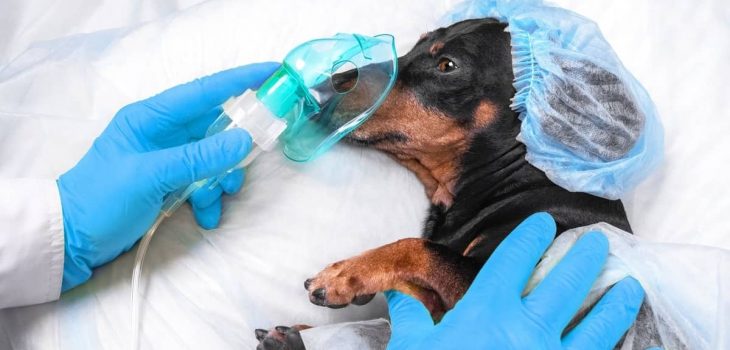The Doxies’ long backs are adorable but that same dachshund spine anatomy can lead to some issues. So, let’s go over the dachshund back surgery success rate and why it’s worth it. We’ll look into the numbers behind IVDD when it’s necessary, what’s the recovery prognosis, and more.
What Is The Dachshund Back Surgery Success Rate?
Even if you’re just now getting your first dachshund puppy you ought to know what Intervertebral Disc Disease (IVDD) is and how it might affect your dog in the future. IVDD doesn’t affect all Doxies, of course, so, if you take a healthy puppy and look after it well, you may never have to deal with this problem. However, some luck is obviously also involved here.
So, say that your dachshund has got a slipped disk due to IVDD and the vet recommends surgery – what’s the dachshund back surgery success rate we’re looking at?
According to studies, dachshunds within the 1-4 grades of IVDD progression have over 90% chance of successful recovery after surgery. However, those dachshunds whose IVDD has been allowed to progress to the 5th grade have just about a 50% to 60% chance for successful recovery.
If you’re curious what those IVDD grades are, there are the 5 typical Pain Response Scores used by veterinary specialists. Given that it takes quite a bit of negligence or bad luck for a dachshund to get to grade 5, the over 90% success rate for most dachshunds is pretty great. And, even for grade 5 IVDD, the fact that the chance for recovery is still over 50% is definitely not bad.
Of course, do keep in mind that these numbers only concern the surgery success rate. For your Doxie to have a complete recovery and be back in near-full health you’ll also need to undergo a weeks-long rehabilitation process using medications, therapy, and immobilization.
When Is Surgery Necessary?
Back surgery is scary even with its 90%+ success rate. Fortunately, it’s not always necessary. Your dog’s physician is going to tell you whether the specific case of IVDD requires surgery or if it’s mild enough that proper therapy, medications, and lifestyle changes are going to be enough.

Learn more about: Dog IVDD Surgery Cost, Risks, Rehabilitation, And Alternatives
In the lightest possible cases, this is indeed a good course of action. In general, Doxies can get better without surgery if 1) they are young, 2) the problem is not that bad, and if 3) this is their first back issue.
If either of these three points isn’t the case, however, your vet will almost certainly recommend surgery. This is not only in order to better deal with the problem but also to make it as unlikely as possible that your dog will ever have back issues again.
It’s perfectly understandable if you want to distrust your vet and refuse surgery. Even with a 90%+ success rate, those remaining 5-10% can be very daunting and overwhelming. Given that your vet will know your dachshund’s individual case and needs better than any random writer on the internet, however, we strongly urge you to trust your vet.
As long as you’ve made sure to find and work with a qualified and experienced professional, their opinion should be the best opinion regarding the necessity for surgery. Plus, if you have doubts, you can also look for a second opinion.
Is The Surgery Expensive?
The cost of IVDD surgery can be rather high, especially depending on where you live. The surgery itself will almost always cost somewhere between $1,500 and $4,000 in the US. This alone is reason enough for many people to contemplate going against the doctor’s orders and skipping surgery. That’s an understandable reaction but it’s rarely the best course of action for your dog.
Things become even more unfortunate when you consider the additional costs that usually follow the surgery, however. When you add up the need for x-rays, therapy, medications, additional vet visits, and other expenses, the average cost tends to rise to anywhere between $3,0000 and $8,000.
We’ve covered the IVDD surgery costs, rehabilitation, and other details more extensively in this article.
How Common Is IVDD In Dachshunds?
It’s impossible to cite an exact statistic on this as many IVDD cases surely go undiagnosed and untreated. We don’t even really know the exact number of dachshunds out there, after all. However, most estimates suggest that about 25% of all dachshunds will get IVDD at one point or another. For reference, that’s two times higher than most other breeds that can get IVDD such as beagles, corgis, Chihuahuas, and others.
Is Reoccurring IVDD In Dachshunds Common?
It’s not uncommon. Again, it’s difficult to get a precise statistic but most estimates suggest that about 25% to 50% of dachshunds will have a reoccurring IVDD problem. The reason for this is two-fold:
- IVDD doesn’t really ever go away. If your Doxie has it, it has it and that’s it. From there, it’s just a matter of making sure that your dog’s spine remains healthy despite the IVDD.
- As with any other statistic, this 25%-50% doesn’t account for all the people who haven’t taken proper care of their Doxies. So, assuming that you do, your dog’s risks for a second slipped disk should be much lower.
Does A Second IVDD Problem Mean Surgery Is Necessary?
Usually – yes. But, again, this is judged on a case-by-case basis by the veterinarian. If your dog has had a second slipped disk (or a second slipping of the same disc), however, this most likely means that the problem is serious enough to necessitate surgery.
In Conclusion, What Is The Dachshund Back Surgery Success Rate, and What Does This Mean For Your Dog?
All things considered, a 90%+ surgery success rate for all but the worst IVDD cases is pretty good. It’s not 100%, of course, so no one should recommend unnecessary surgeries. However, if a qualified veterinary expert tells you that surgery is the better option and your dog has 90%+ chances for full recovery, this is likely your best bet.
From there, it’s all just a matter of proper rehabilitation, a few lifestyle changes such as ramps on furniture and stairs, and good care. And a bit of luck.




